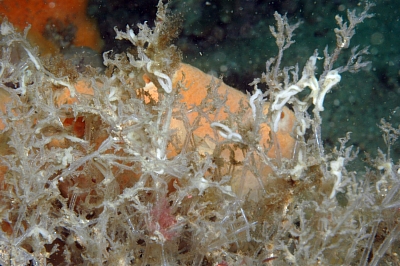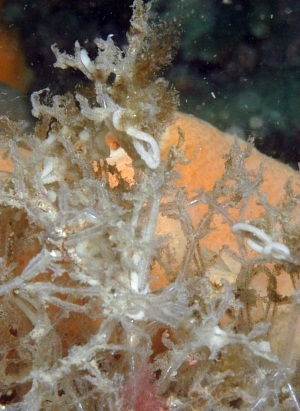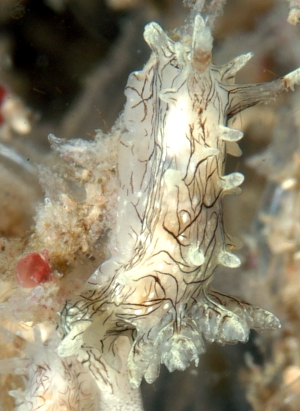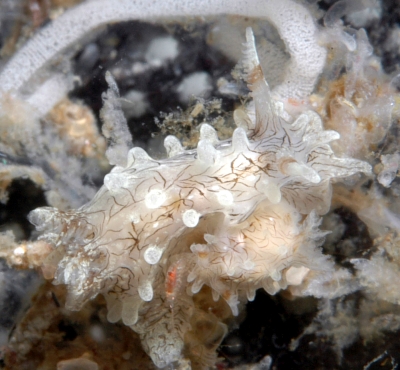Okenia pellucida from eastern Australia
January 31, 2008
From: Leanne & David Atkinson

Concerning message #19476:
Dear Bill,
It has been some years since we encountered Okenia pellucida at Port Stephens but we have found it again this season. The prolific egg rings in the host bryozoan like a decorated Christmas tree drew our attention. The Okenia were difficult to see because they were so tiny. We used the minimum focus 1:1 of our macro lens to even see them. When we put the images on the computer it was easy to see that the host was covered with an "infestation" of them. Presumably the eggs belong to this species but we're not sure that we actually captured any in the process of laying them. You don't seem to have any egg photos for this species so we thought this might be of interest.In the process of sending this in we noticed the notes on Okenia zoobotryon and realised we had seen a couple of those on the same host so we will send them in a separate message [#21336]. The majority of nudibranchs we could see on the bryozoan were Okenia pellucida.
Locality: Halifax Sponge Gardens, Port Stephens - Great Lakes Marine Park, Port Stephens, 15 metres, New South Wales, Australia, Pacific, 30 December 2007, Sandy bottom, scattered sponges, ascidians, soft corals, kelp and bryozoans.. Length: 5 to 10 mm. Photographer: Leanne & David Atkinson.
Best wishes,
Leanne & David Atkinson
atk@hunterlink.net.au



Dear Leanne & David,
Okenia zoobotryon gets it name from the bryozoan, Zoobotryon verticillatum, on which it feeds. Okenia pellucida also feeds on this bryozoan and your photos are very welcome. Both species are very dependent on the presence of the bryozoan, which is a well-known fouling organism throughout the world. It is usually one of the first organisms to colonise cleared spaces, but it is not very good at retaining its territory, so it is quickly overgrown or eaten by slower growing but more aggressive plants and colonial animals. Because of its fleeting presence, the species of Okenia which feed on it are rare and short-lived visitors to any particular spot, but when they are present they are usually in large numbers.
Best wishes,
Bill Rudman
Related messages
-
Okenia pellucida from Ratnagiri, India
From: Vishal J. Bhave, April 25, 2010 -
Re: Okenia pellucida from eastern Australia
From: Leanne & David Atkinson, February 28, 2008 -
Okenia pellucida from Lembeh,North Sulawesi
From: Francis & Pirjo Pellet, June 4, 2007 -
Radula of Okenia pellucida
From: Bill Rudman, December 21, 2004 -
Bryozoan food of Okenia pellucida
From: D.& L. Atkinson, February 29, 2000 -
Okenia pellucida from New South Wales
From: D.& L. Atkinson, February 23, 2000 -
Re: Okenia pellucida
From: Tomohiko Kurihara, October 8, 1999 -
First record of Okenia pellucida from Japan
From: Tomohiko Kurihara, October 6, 1999
